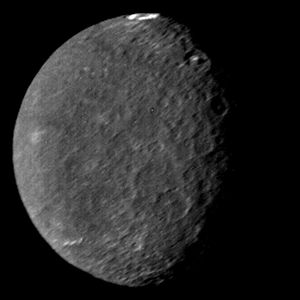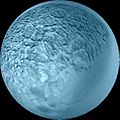Umbriel (moon) facts for kids

Umbriel as seen by Voyager 2 in 1986
|
|||||||||
| Discovery | |||||||||
|---|---|---|---|---|---|---|---|---|---|
| Discovered by | William Lassell | ||||||||
| Discovery date | October 24, 1851 | ||||||||
| Designations | |||||||||
| Pronunciation | UM-bree-əl | ||||||||
| Uranus II | |||||||||
| Adjectives | Umbrielian | ||||||||
| Orbital characteristics | |||||||||
| 266 000 km | |||||||||
| Eccentricity | 0.0039 | ||||||||
| 4.144 d | |||||||||
| Inclination | 0.128° (to Uranus's equator) | ||||||||
| Satellite of | Uranus | ||||||||
| Physical characteristics | |||||||||
|
Mean radius
|
584.7 ± 2.8 km (0.092 Earths) | ||||||||
| 4 296 000 km2 (0.008 Earths) | |||||||||
| Volume | 837 300 000 km3 (0.0008 Earths) | ||||||||
| Mass | 1.172 ± 0.135 × 1021 kg (2 × 10−4 Earths) | ||||||||
|
Mean density
|
1.39 ± 0.16 g/cm3 | ||||||||
| 0.2 m/s2 (~ 0.023 g) | |||||||||
| 0.52 km/s | |||||||||
| presumed synchronous | |||||||||
| 0 | |||||||||
| Albedo |
|
||||||||
|
|||||||||
| 14.5 (V-band, opposition) | |||||||||
| Atmosphere | |||||||||
|
Surface pressure
|
zero | ||||||||
Umbriel is a moon of Uranus found on October 24, 1851 by William Lassell. It was found at the same time as Ariel.
Name
The name "Umbriel" and the names of all four moons of Uranus then known were suggested by John Herschel in 1852 at the request of Lassell. Lassell had earlier supported Herschel's 1847 naming scheme for the seven then-known moons of Saturn and had named his newly-found eighth moon Hyperion in accordance with Herschel's naming scheme in 1848.
It is also designated Uranus II.
Physical characteristics
So far the only close-up images of Umbriel are from the Voyager 2 probe, which made observations of the moon during its Uranus flyby in January, 1986. During the flyby the southern hemisphere of the moon was pointed towards the Sun so only it was studied.
Umbriel's surface is the darkest of the Uranian moons, and reflects only about half as much light as Ariel, Uranus' brightest moon. It has far more and bigger craters than do Ariel and Titania and is also the least geologically active. It is mostly made of water ice, with the balance made up of silicate rock, and other ices such as methane. Methane can break down and form reddish-black organic compounds such as tholins when bombarded by high-energy particles. Near-IR spectra of Ariel and Umbriel clearly show that water ice dominates the spectra of these objects.
Craters
Craters on Umbriel are named after many different demons from various mythologies.
| Crater | Named after |
|---|---|
| Alberich | Alberich (Norse) |
| Fin | Fin (Danish) |
| Gob | Gob (Pagan) |
| Kanaloa | Kanaloa (Polynesian) |
| Malingee | Malingee (Australian Aboriginal mythology) |
| Minepa | Minepa (Makua people of Mozambique) |
| Peri | Peri (Persian) |
| Setibos | Setebos (Patagonian) |
| Skynd | Skynd (Danish) |
| Vuver | Vuver (Finnish) |
| Wokolo | Wokolo (Bambara people of West Africa) |
| Wunda | Wunda (Australian Aboriginal mythology) |
| Zlyden | Zlyden (Slavic) |
Images for kids
See also
 In Spanish: Umbriel para niños
In Spanish: Umbriel para niños




